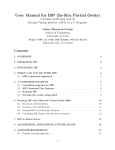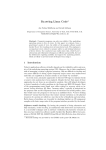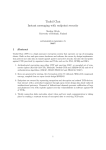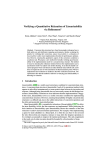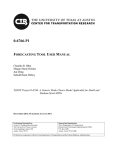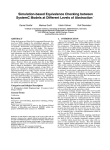Download 1 Introduction - Utah Verification Group
Transcript
Practical Formal Verification of MPI and Thread Programs
Tutorial Notes
Ganesh Gopalakrishnan
School of Computing, University of Utah, Salt Lake City, UT 84112
http://www.cs.utah.edu/formal verification/europvm09-tutorial-mpi-threading-fv
http://www.cs.utah.edu/formal verification/ISP-release
1
Introduction
This document is being prepared to serve as a reference for the tutorial with the same title that will be offered
during EuroPVM/MPI 2009 in Espoo, September 7, 2009. In this tutorial, we will mostly focus on the topic
of formal dynamic verification [1] of MPI programs using our tool ISP. There will also be a short session on
shared memory program verification using our tool Inspect. Section 4 discusses Inspect/threading; until this
section, this document focuses on ISP and MPI dynamic formal verification. In this tutorial document, we
assume familiarity with MPI and basic threading concepts. In the EuroPVM/MPI tutorial, we will provide
short introductions to MPI and threading.
ISP (In-Situ Partial order) is our dynamic formal verification tool for MPI programs. Currently, ISP
can verify MPI C programs (Fortran porting is underway), and employs available standard MPI libraries
to provide the semantics of MPI calls. So far, ISP has been tested successfully using the MPI libraries
MPICH2, OpenMPI, and Microsoft MPI. To a lesser extent, ISP has also been tested using MVAPICH
and IBM MPI. ISP has been successfully run on the Linux, Mac OS/X, and Windows operating systems.
As to graphical user interfaces, ISP has two of them, one created using Visual Studio and the other using
Eclipse. This document is written without specific references to the particular high level language, MPI
library, operating system, or GUI used by ISP. It is meant to cover the basic principles underlying all these
versions of ISP. Specific details pertaining to these platforms, including user manuals, are available on the
ISP website.
With these preliminaries out of the way, we are now ready to present the heart of ISP – namely, its
central algorithm POE (Partial Order avoiding Elusive interleavings). We name the algorithm employed by
ISP separately because in future we plan to have other algorithms in lieu of POE (the tool name is expected
to remain ISP). Let us study POE using the example executions shown in Figure 1. In the pseudo-code
presented in this figure, we have suppressed details of the data shipped by the communication commands,
as well as computation oriented statements that would typically be employed between MPI calls. Also we
employ * to highlight wildcard receive.
P0
-Irecv(from:*,req);
P1
-<-------
P2
-Send(to:0);
Recv(from:2); --?-- Send(to:0);
P0
P1
--Irecv(from:*,req); <-- Send(to:0);
P2
--
Recv(from:2);
<--
Send(to:0);
Send(to:2);
Recv(from:0);
Send(to:2);
-->
Recv(from:0);
Recv(from:*);
Send(to:0);
Recv(from:*);
<--
Send(to:0);
Wait(req);
Wait(req);
LUCKY SCENARIO!
UNLUCKY SCENARIO!
Figure 1: Two execution scenarios of a simple MPI program
1
In the run entitled LUCKY SCENARIO, because of the timings in the system, P2’s Send(to:0)
matches with P0’s Irecv(from:*,req). However, this will result in a deadlock as shown by the
actions connected by --?-- which cannot match, and hence the execution freezes at this point. This
execution is called ‘lucky’ because a test engineer would detect the deadlock during testing if this scenario
were to manifest during testing. But suppose the execution shown on the right-hand side entitled UNLUCKY
SCENARIO is all that emerges during testing; the test engineer could then consider the program to be
correct and ship it. A customer who uses the program may, however, encounter the first behavior (not so
‘lucky’ for him/her)!
This simple example illustrates the futility of testing concurrent programs in general, and MPI programs
in particular. One simply has no idea what the communication delays on a machine are, or the scheduling
policies used by the MPI runtime or the underlying operating system. One popular approach to increase
the changes of bug detection is to perturb schedules by throwing in ‘random sleep’ statements into the
code. While this method can often help manifest previously untried schedules (interleavings), it certainly
provides no guarantees of covering all relevant schedules, or of covering each interleaving exactly once.
Besides, the delays introduced can slow down the whole testing process. These are the deficiencies that
POE overcomes.
In a nutshell, ISP’s verification attempts to simulate all possible speed/scheduling/machine variations
in one fell swoop. ISP achieves this by employing the architecture shown in Figure 2. The MPI actions
issued by the executable are shown as MPI_f for some MPI function f. These functions are intercepted,
and issued as PMPI_f into the MPI runtime, but only as and when dictacted by the POE algorithm. The
POE algorithm opportunistically rearranges the sequence of MPI_f calls seen to a different sequence of
PMPI_f calls. It also alters some of the functions f sent into the runtime. All this is done to pursue the set
of all relevant interleavings. In other words, POE de-biases from the specific delays or scheduling policies
of the platform on which verification using ISP is being conducted such that when a program is shown
correct by ISP, it remains correct no matter what the MPI library or platform that the customer may have!
We now discuss these ideas beginning with the notion of relevant interleavings.
1.1
Relevant Interleavings
So what are the relevant interleavings to be executed in an MPI program? In the example in Figure 1,
the relevant interleavings are both the LUCKY and the UNLUCKY executions. In the example shown in
Figure 3 also, there are two relevant interleavings, one for each Isend match with the wildcard Irecv.
ISP
ISP Profiler
MPI_f
Source files
Executable
Scheduler
signals
PMPI_f (w/ goahead
signal from the Scheduler)
MPI runtime
Figure 2: Overview of ISP
2
b
P0: Isend(to:1, data = 42) ; ...
P1: Irecv(from:*, x)
; if (x==42) then error1 else ...
P2: Isend(to:1, data = 21) ; ...
Figure 3: Simple MPI Example Illustrating Wildcard Receives
This example shows that depending on the non-deterministic wildcard match, the control flow following
the Irecv can vary. Specifically, the error error1 is triggered depending on the Isend that matches
the wildcard receive Irecv. ISP’s approach to generate all relevant interleavings is to track all nondeterministic constructs, and ensure that each of them is examined in the most general (“schedule debiased”) manner.
While all this is a special case of the well known1 partial order reduction (POR) approach [2, Chapter
10], ISP’s approach to POR is considerably different from that taken in the case of classical shared memory
in-order execution languages. The out-of-order execution semantics, together with the rich set of collective
operations that MPI uses results in POE being dramatically different from traditional POR algorithms, as
explained in the sections to follow. Overall, POE’s execution method is quite different from those used in
all dynamic verification tools we know of.
1.2
Dynamic Rewriting and Reordering
In order to generate all relevant schedules, it is not sufficient to control the issue order of MPI calls. For
instance, in Figure 3, it is not sufficient to issue the Isend of P0 and that of P2 in a certain order. The
MPI runtime will, most likely, not heed this issue order and internally re-arrange things so that P0’s Isend
(for example) always ends up matching P1’s Irecv. The general idea is that ISP’s profiler and scheduler
(Figure 2) trap MPI commands, and issue these commands into the MPI run-time “when convenient,” or
“only when forced.”
Two crucial aspects of ISP are dynamic re-ordering and dynamic re-writing. Even though the MPI calls
pour into the scheduler according to the program order of the MPI processes, the scheduler may – if warranted – permute this order into the internal issue order. Such reorderings will be illustrated in Section 1.3.
Also, when issuing the MPI calls, the scheduler may also choose to dynamically replace the arguments
of various calls. In the example of Figure 1, the scheduler will replace Irecv(from:*,req) with
Irecv(from:1,req) during one interleaving. This will create the UNLUCKY SCENARIO. It will then
re-execute the MPI program, but now replace Irecv(from:*,req) with Irecv(from:2,req),
thus forcing the LUCKY SCENARIO. The same kind of rewriting will also ensure that error1 of Figure 3 will be caught when Irecv(from:*) is replaced by Irecv(from:0) during one of the replays,
and the value of 42 flows into x.
1.3
Handling Barriers and Collectives
According to the MPI library semantics, no MPI process can issue an instruction past its barrier unless
all other processes have issued their barrier calls. This does not mean that the operations issued before
the barrier have “finished” (what ‘finished’ means will be defined later). Therefore, an MPI program must
be designed in such a way that when an MPI process reaches a barrier call, all other MPI processes also
reach their barrier calls (in the MPI parlance, these are collective operations); a failure to do so deadlocks
1
If you don’t know about POR, please do not worry; please skip all such remarks intended at those who do.
3
P0: Isend0(to:1, h0) ; Barrier0 ; Wait(h0)
P1: Irecv(from:*, h1) ; Barrier1 ; Wait(h1)
P2:
Barrier2 ; Isend2(to:1, h2) ; Wait(h2)
Figure 4: Illustration of Barrier Semantics and the POE Algorithm
the execution. While these rules match the rules followed by other languages and libraries in supporting
their barrier operations, in the case of MPI, it is possible for a process Pi to have a non-blocking operation
OP before its barrier call, and another process P j to have an operation OP’ after P j ’s matching barrier call
where OP can observe the execution of OP’. This means that OP can, in effect, complete after Pi ’s barrier
has been invoked. Such behaviors are allowed in MPI to keep it a high-performance API.
Figure 4 illustrates the scenario just discussed. In this example, one Isend issued by P0, shown as
Isend0(to:1, &h0), and another issued by P2, shown as Isend2(to:1, &h2), target a wildcard Irecv issued by P1, shown as Irecv(from:*, h1). The following execution is possible:
(i) Isend0(to:1, &h0) is issued, (ii) Irecv(from:*, h1) is issued, (iii) each process fully executes its own barrier, and this “collective operation” finishes, (iv) Isend2(to:1, h2) is issued, (v) now
both sends and the receive are alive, and hence Isend0 and Isend2 become dependent (non-deterministic
matches with Irecv), requiring a dynamic algorithm to pursue both matches. Notice that Isend0 can
finish before Barrier0 and Irecv can finish after Barrier1. We sometimes refer to the placement of
barriers as in Figure 4 as “crooked barriers,” because the barriers are used even though there are instructions
around it that observe each other.
To handle this example properly, the POE algorithm of ISP cannot assume that Isend0 is the only
sender that can match Irecv. Therefore ISP must somehow delay issuing Irecv into the MPI run-time
until all its matchers are known. In this example, ISP will collect Isend0 and Irecv, then issue all the
Barriers, then encounter Isend2, and then only act on R. Here, ISP will issue Irecv with arguments
0 and 2 respectively in two consecutive replays of the whole program. Thus, the inner workings of ISP’s
POE algorithm are as follows:
•
•
•
•
Collect wildcard receives
Delay non-blocking sends that may match the receives
Issue other non-interfering operations (such as the Barriers)
Finally, when forced (in the example in Figure 4, the forcing occurrs when all processes are at their
Wait statements), ISP will perform the dynamic re-writings, followed by the two replays.
The example of Figure 4 illustrates many aspects of POE:
• Delaying of operations: Irecv was delayed in this example;
• Out of order issue: the Barriers were issued out of program order;
• Being forced to compute the full extent of non-determinism: In our example, when all processes
are at fence instructions – meaning, instructions such as Wait and Barrier – the POE algorithm
knows that none of the sends coming after the fence can match the wildcard Irecv. (We will define
a fence later on in Section 3.2.) This allows POE to compute the full extent of non-determinism
on-the-fly.
• Replay: For each case of non-determinism, ISP only remembers the choices by keeping a stack trail.
The full MPI runtime state cannot be remembered (it is too voluminous, spread over clusters, and
consists of the entire state of a large machine). Thus, ISP always resorts to the approach of starting
from the initial state (known) and computing up to a choice point, and then branching differently
4
P0
-Isend(to:1,req);
P1
-Irecv(from:*,req);
P2
-Barrier;
Barrier;
Barrier;
Isend(to:1,req);
Wait(req);
Recv(from:2);
Wait(req);
Figure 5: POE Illustration
at the choice point. This approach has been employed in almost all stateless dynamic verification
approaches that were pioneered in [1].
2
Illustration of POE through an Example
We will now explain at some length how POE will treat the example in Figure 5. This example will help
understand the semi-formal description of POE given in Section 3.
• POE starts with P0.
• It will collect but does not issue Isend into the MPI runtime. Since this is a non-blocking call, POE
stays with P0.
• It will collect but does not issue Barrier into the MPI runtime. POE now realizes that P0 is at a
fence, and hence it switches to P1. We define an instruction I to be a fence if all later instructions in
program order are guaranteed to be matched only after I is matched. In our example subset of MPI,
Barrier and Wait are fences. In general, all blocking MPI calls are fences. We prefer the term fence in
lieu of blocking call because normally a Barrier is viewed as a collective call and not a blocking
call in the MPI parlance.
• In the same manner, POE collects Irecv and Barrier from P1, then switches over to P2.
• It collects Barrier from P2.
• Now that all processes are at a fence, we form the currently formable match sets. There is only one
match set – namely, the Barrier instructions. A match set is a collection of MPI commands that
“go together,” or are “performed together” – for instance, all matching barriers, a send and its receive,
etc. There are also singleton match sets, for example a Wait whose Isend/Irecv have drained/filled
their message buffers.
•
•
•
•
Note that we do not form a match set out of Isend of P0 and Irecv of P1 because since this barrier
is also “crooked,” Isend of P2 can match Irecv of P1. Wildcard receive match sets are formed
only (i) when all processes are on fences, and (ii) a non wild-card match set cannot be formed. This
fact will be addressed once again in Section 3.
Since we could form a non wild-card match set (namely the match set of Barriers), we restart the
POE algorithm, coming back to P0, and collecting (but not issuing) its Wait.
Since Wait is a fence, POE shifts to P1’s Recv, which is like Irecv fused with an immediately
following Wait (and hence this is also a fence).
Then POE moves over to P2 and continues working on P2 (since the other processes are at fences.
When Wait from P2 is encountered, all processes are once again at fences.
At this point, POE can form a set of match sets involving Isend(to:1,req), Irecv(from:*,req),
and Isend(to:1,req) . The match set members are {Isend(to:1,req), Irecv(from:0,req)} , and
5
. This is a wildcard match set, and no other non wildcard match set exists. Hence we can now be sure that Irecv(from:*) of P1 will have no more
matching sends! (If there were one more process in this program and through that we had a non
wild-card match set, we could have executed that, moved forward, and perhaps found yet another
send matching this wildcard receive.)
• POE backtracks over these match set members. If it proceeds via the second of these match sets, i.e.
{Isend(to:1,req), Irecv(from:2,req)}, then Recv(from:2) no longer has a communicating partner, and this results in a deadlock.
{Isend(to:1,req), Irecv(from:2,req)}
The reader is invited to consider the other match set which does not reveal a deadlock.
3
Semi-Formal Description of POE
In our discussions so far, we have made many bold claims such as “changing the order between Isend and
Barrier does not matter.” We also loosely alluded to notions such as operations “finishing.” The formal
semantics of ISP are described in our FM 2009 paper. This section attempts to summarize the main aspects
of POE.
3.1
States of MPI Calls
Each MPI call goes through up to four states: issued (notated as B), returned (C), matched (♦), and completed (•). Some calls (e.g., Isend) go through all these states, while others (e.g., Wait) does not have a
matched, or ♦ state, and hence its completed, or • state may be taken to be the same as its matched state.
Here are pertinent details of these events:
issued (B): The MPI function has been issued into the MPI runtime.
returned (C): The MPI function has returned and the process that issued this function can continue executing. For a non-blocking call, this event occurrs immediately after the issue event.
matched (♦): Since most MPI functions usually work in a group (for example, a send from one process will
be matched with a corresponding receive from another process), an MPI function is considered matched
when the MPI runtime is able to match the various MPI functions into a group which we call a match set.
Another example of a match set is the one contributed to by a Barrier (B): all the barrier calls match at some
point. All the MPI calls in the match set will be considered as having attained the matched state.
complete (•): An MPI function can be considered to be complete according to the MPI process that issues
the MPI function when all visible memory effects have occurred (e.g., in case the MPI runtime has sufficient
buffering, we can consider an Isend to complete when it has copied out the memory buffer into the runtime
bufer). The completion condition is different for different MPI functions (e.g., the Irecv matching the
Isend may not have seen the data yet, but still Isend can complete on the send side).
3.2
Happens-before
An MPI receive call “happens” when its match (♦) event occurs. An MPI wait call “happens” when its
completed (•) event occurs. Without peering into these “inner events” associated with an MPI call, we can
define an abstract happens-before relation between MPI calls. The details of such an intra happens-before
relation for MPI was discovered by us (we call it simply by “MPI happens before”; in future papers, we
will discuss MPI’s inter happens-before relation). For simplicity, we consider only the non-blocking send
(S), non-blocking receive (R), wait (W), and barrier (B).
6
• Two non-blocking sends (S) are happens-before ordered in program order if they target the same
destination process.
• Two non-blocking receives (R) are happens-before ordered in program order if they source the same
source process.
• A wildcard receive always happens-before before any following receive.
• A non-blocking send (S) and its wait (W) are happens-before ordered in program order.
• A non-blocking receive (R) and its wait (W) are happens-before ordered in program order.
• All instructions following (in program order) a barrier (B) are happens-before ordered after it.
• All instructions following (in program order) a wait (W) are happens-before ordered after it.
• Nothing else is happens-before ordered.
(a) Example Illustrating Happens-before
(b) The Happens-before Relation
Figure 6: Example Illustrating Happens-before
Consider the example in Figure 6(a). The horizontal dotted arrows depict the communications being attempted in this example. The full happens-before relation for this example is shown in Figure 6(b). There is
a happens-before between Isend(to:1,h1) and Isend(to:1,h2) because they target the same process (namely P1), and likewise between Isend(to:2,h3) and Isend(to:2,h4) also. Each of these
sends and their matching waits are happens-before ordered. However there is no happens-before between
Isend(to:1,h1) / Isend(to:1,h2) and Isend(to:2,h3) / Isend(to:2,h4). In an actual
execution of this MPI program, it is possible for users to witness Isend(to:2,h3) or Isend(to:2,h4).
finish before Isend(to:1,h1) or Isend(to:1,h2) even start! This makes perfect sense from a performance point of view if the third and fourth send of P1 are shipping far smaller messages.
Notice another surprising fact: there is no happens-before between the first four sends of P0 and
Irecv(from:1,h9)! Likewise, there is no happens-before between the first two receives of P1 and
the Isend(to:0, h8) of P1. This may be puzzling: users may wonder: what if Isend(to:0,h8)
picks up a piece of data received by Irecv(from:0,h6) and tries to send it back to P0? Fortunately, this is not an issue because it is illegal for Isend(to:0,h8) to be using the data received by
Irecv(from:0,h6), because this non-blocking receive is still in progress, and its wait (namely W(h6))
hasn’t yet been encountered! So really speaking, in this program, one may observe the Isend(to:0,h8)
to Irecv(from:1,h9) communication as the first observable activity!
The POE maintains a dynamically evolving happens-before graph for each MPI process. Each time a
new instruction is collected from an MPI process, POE extends the happens-before according to the rules
described above. “Collect” means “advance the PC over the instruction.” All happens-before edges are
7
intra process – we don’t have the notion of an inter happens-before in POE (we have another algorithm
under construction called POEMSE that does maintain inter happens-before).
For two instructions X and Y, X is an ancestor of Y if X is happens-before ordered before Y; Y is called
a descendent of X. Each instruction collected by POE may have been matched or may be as yet unmatched.
Since happens-before is a partial order, at any point in time, POE can have a set of one or more instructions
without ancestors. By the same token, it is also possible for a process to have more than one instruction with
all its ancestors having been matched. Such instructions – those whose ancestors have all been matched
– are eligible to match. When we say “pick an eligible-to-match instruction” in the following sequel, we
mean one of those instructions.
Define an instruction I to be a fence if all later instructions in program order are guaranteed to be
happens-before ordered after I (earlier on Page 5, we defined a fence in a much more informal manner).
Call a process to be at a fence if its current instruction is a fence. For our purposes, a process is at a fence
if it is at a blocking call, namely at a B or at a W. For simplicity, we consider only the following instruction
types:
•
•
•
•
non-blocking send (S)
non-blocking receive - wildcard (R(*)) or non-wildcard (R). We abbreviate wildcard as WC.
wait (W)
barrier (B)
Let P0 ,. . .,PN−1 be the N processes of an MPI program. Start with P0 as the current process, and the
first instruction of each process as the current instruction (instruction at the current PC whicl starts at 1).
Since these instructions have no ancestors, they are also eligible to match. Finally, let state S (the argument
of POE below) encapsulates the entire execution state of the MPI program including: the current PC and
the current instruction of each process, the HB graph of each process, and the eligible to match set of each
process. We express POE as a recursive algorithm, and in fact during the actual implementation, we do
arrange for the recursive semantics to be achieved by backtracking and replaying. With these notions in
place, here is the pseudo-code of POE.
3.3
3.3.1
Illustrations of POE
Simple Examples of “Auto Send”
As our first illustration, consider the following single process (rank) MPI pseudo-code program where, for
simplicity, we have suppressed all message buffers:
P0: Irecv(from:0,h1); Barrier; Isend(to:0,h2); Wait(h2); Wait(h1);
Curiously, P0 is trying to send to itself, which is allowed in MPI. The happens-before relation is as follows:
from Barrier to all following instructions; from Irecv to its Wait, and from Isend to its Wait; from
each Wait to all following instructions.
POE will collect Irecv, then collect Barrier. It forms the singleton non wild-card match set
Barrier and issues it. This makes Isend to issue. Now a non wild-card match set of Irecv and
Isend can be formed. These are issued. Now Wait(h2) becomes eligible to match. According to the
MPI semantics, this Wait(h2) can return only when Isend has copied its buffer out of the process space.
Where Isend puts this resulting data depends on the MPI implementation. If the MPI runtime has sufficient buffering of its own, then clearly this Isend can void its buffer. But since Irecv has been posted,
8
1:
2:
3:
4:
5:
6:
7:
8:
9:
10:
11:
12:
13:
14:
15:
16:
17:
18:
19:
POE(S) {
if (any local assertion is violated in S)
Error report; Return;
if (all procs are at a finalize state in S)
Check for MPI object leaks; Return;
if (there is a proc not at a fence instruction in S)
0
Let S be obtained by advancing the PC of this proc, and extending the HB graph;
0
POE(S );
if (a non wild-card match set can be formed)
0
Let S be obtained by issuing the match set operations, and updating eligible to match;
0
POE(S );
// All procs are at fences and no non-WC match set is formable
for (all WC match sets m)
for (all dynamic rewrites of m resulting in a match set ms)
0
Let S be the state resulting from expanding this WC match set as follows:
Issue the constituent instructions of ms;
Update the Eligible to Match relation;
0
POE(S );
}
Figure 7: POE Pseudo-code
it is required that P0 itself pick up the data sent out by Isend (see Note below), allowing Isend (and its
wait) to return. This program executes deadlock-free in all MPI implementations.
Note: We are unsure whether the standard requires this. In the ISP implementation, we package a fake Wait along with non-blocking operations because we have encountered at least one
MPI implementation where Isend and Irecv do not progress till their waits are seen. In
this case, ISP nullifies the real Wait when it comes along later. If such a Wait does not come
along, the faked wait still does not count as far as resource leak reporting goes (i.e., we may
have faked a wait, but if a real wait does not come along, it is still flagged as a resource leak).
Let us discuss further variations of this program, all discussed with respect to MPI runtimes that do not
provide sufficient run-time buffering. A deadlock-free variant of the above program is
P0: Irecv(from:0,h1); Barrier; Isend(to:0,h2); Wait(h1); Wait(h2);
Here, waiting for Irecv first through Wait(h1) is safe, because eventually this Irecv is supposed to
finish (again, subject to Note above).
However, the following version deadlocks, because the Wait of the receive has to finish before Isend
can even be initiated.
P0: Irecv(from:0,h1); Wait(h1); Barrier; Isend(to:0,h2); Wait(h2);
3.3.2
Example in Figure 6
From the HB graph in Figure 6, it is easy to see that all of the following can be issued into the MPI runtime
even in the very first step of execution:
9
•
•
•
•
•
•
Isend(to:1, h1)
Isend(to:2, h3)
Isend(to:0, h8)
Irecv(from:0, h5)
Irecv(from:1, h9)
Irecv(from:0, h7)
In particular, as pointed out earlier, one may observe the Isend(to:0,h8) to Irecv(from:1,h9)
communication as the very first activity in this MPI program.
3.3.3
Cross-Coupled Processes
This section illustrates one very non-obvious aspect of MPI programs, and why the recursive invocation
beginning at Line 14 of Figure 7 is crucial for handling such examples. Here is the point. At line 13, we
may have two distinct wild-card match sets m1 and m2. In particular, m1 itself may be comprised of one
wildcard receive and two matching sends, and likewise m2 may be comprised of one (seemingly completely
0
unrelated) wildcard receive and its own two matching sends. At line 14, we go with m1, calculate S using
0
it, and issue POE(S ) recursively at line 18. Does m2 remain “frozen” at its current state – i.e. are we
really sure that the set of sends that match the wildcard receive within m2 remains at the initial two we
0
discovered while at line 13? The answer is no! When we go with m1, calculate S using it, and issue
0
POE(S ) recursively at line 18, we may engage in new code that issues yet another send (call it “new send”)
that also matches the wildcard receive within m2! Since POE has no such ‘look-ahead knowledge,’ it has
0
to play conservatively, doing what we express in Figure 7. That is, when we go with m1, calculate S using
0
it, and issue POE(S ) recursively at line 18, we are starting afresh at line 1, and this will result in the “m2
match set” being re-calculated in the light of the new send that we would have discovered.
All this is brought to clearer light by the following example. We employ an abstract syntax showing
the code of each MPI process as a straightline program (Figure 8), suppressing all intervening C statements
as before. Each MPI call is decorated with two subscripts, namely the process index and the rank within a
process. In this example, the first send of P1 , i.e. S1,1 (0), aims to send a data payload (not shown) to process
P0 (the argument 0 of S1,1 signifies this). Its corresponding wait is W1,2 (h1, 1i) (we often employ pairs such
as h1, 1i to denote handles). We leave out the “to” and “from” designators from sends and receives.
P0
R0,1 (∗)
P1
S1,1 (0)
P2
R2,1 (∗)
P3
S3,1 (2)
W0,2 (h0, 1i)
W1,2 (h1, 1i)
W2,2 (h2, 1i)
W3,2 (h3, 1i)
R0,3 (∗)
S1,3 (2)
R2,3 (∗)
S3,3 (0)
W0,4 (h0, 3i)
W1,4 (h1, 3i)
W2,4 (h2, 3i)
W3,4 (h3, 3i)
Figure 8: Example Requiring Look-ahead Ample Sets
In Figure 8, the match of R0,1 (∗) is initially S1,1 (1), and that of R2,1 (∗) is S3,1 (2). Pursuing the first
match set eventually makes S1,3 (2) also eligible for a match with R2,1 (∗). There is a similar expansion of
the match set of R0,1 (∗) possible from S3,3 (0) when the match between R2,1 (∗) and S3,1 (2) is pursued. Since
POE does not have such look-ahead knowledge, we will handle things conservatively on Line 13.
While correct (we will formalize the correctness proof elsewhere), what performance impact does this
decision have? Observe that we can end up doing ‘part of the work’ at first, and then the ‘whole of the
work’ properly again. More specifically,
10
• We will match R2,1 (∗) and S3,1 (2) initially, and then pursue R0,1 (∗) along with S1,1 (1) and S3,3 (0).
• Then we will match R0,1 (∗) and S1,1 (0) initially, and then pursue R2,1 (∗) along with S3,1 (2) and S1,3 (2).
In other words, while the match set consisting of R2,1 (∗) and S3,1 (2), and that consisting of R0,1 (∗) and S1,1 (0)
appear completely isolated, we recursively expand out all transitions emanating from the initial state, thus
foregoing the advantages of partial order reduction. The advantage given up is of course necessary if/when
we encounter S1,3 (2) and S3,3 (0) that induce further dependencies. However, in the absence of “cross
coupled” dependencies such as S1,3 (2) and S3,3 (0), we might have pursued (say) R2,1 (∗) and S3,1 (2), and
from the resulting state pursue R0,1 (∗) and S1,1 (0). Such an improved algorithm, namely POEMSE , has been
conceived and prototyped, but is not part of the released version of ISP.
There are many practical examples where the initial set of wildcard match sets are truly independent.
For example, the MADRE (Memory Aware Data Redistribution Engine of Siegel) and the MPI-BLAST
(genome sequencing using MPI) code bases both exhibit this pattern. In both these applications, there is
absolutely no ‘cross-coupling’ of dependencies whatsoever. Naturally, when we apply POE, we obtain unnecessary interleaving explosion. This means that an algorithm such as POEMSE will be important in our
continued use of ISP.
3.3.4
ISP: Additional Practical Examples and Concluding Remarks
Several examples will be presented during the course of our tutorial. These examples are all well described
in our URL cited on our first page. The user manual of ISP describes the usage of ISP using interactive
commands.
4
Shared Memory Thread Program Verification using Inspect
This section briefly describes one example that will be examined in some detail during our EuroPVM/MPI
tutorial. Consider Figure 9 in which two threads attempt to acquire two different locks, namely lock and
mutex. This program will be instrumented by Inspect through its front end that is based on the Berkeley
CIL framework. This front end automatically detects and wraps global variables as well as all Pthread
calls. Inspect employs the classic dynamic partial order reduction algorithm [3] with several efficiency
enhancements. The deadlock detected involves the scenario where thread A is holding lock whereas
thread B is about to attempt to acquire lock – but after having acquired mutex. Alas, thread A cannot
release lock unless it can acquire mutex – causing a circular wait.
void * thread_A(void* arg)
{
pthread_mutex_lock(&mutex);
A_count++;
if (A_count == 1)
pthread_mutex_lock(&lock);
pthread_mutex_unlock(&mutex);
void * thread_B(void* arg)
{
pthread_mutex_lock(&mutex);
B_count++;
if (B_count == 1)
pthread_mutex_lock(&lock);
pthread_mutex_unlock(&mutex);
pthread_mutex_lock(&mutex);
A_count--;
if (A_count == 0)
pthread_mutex_unlock(&lock);
pthread_mutex_unlock(&mutex);
}
pthread_mutex_lock(&mutex);
B_count--;
if (B_count == 0)
pthread_mutex_unlock(&lock);
pthread_mutex_unlock(&mutex);
}
Figure 9: Example Pthread program with a deadlock
11
4.1
A Inspect User Manual
Inspect is a tool for systematic testing multithreaded C programs under specific inputs. It can systematically explore different interleavings of multithreaded programs under specific inputs by repeatedly executing the program. Inspect is aimed to reveal concurrency related bugs, such as data races, deadlocks,
etc. (Because of the lack of a C++ source code transformer, Inspect cannot automatically instrument C++
programs. With manual instrumentation, we can still use Inspect to check multithreaded C++ programs.
But you need to know more about how Inspect works to do the manual instrumentation. )
4.1.1 Download and Installation
The file ./inspect-0.1.tar.gzinspect-{version}.tar.gz contains the complete source distribution.
Inspect is written in C++ and Ocaml. You need http://caml.inria.frOcaml release 3.10 or higher,
and a C++ compiler to build Inspect. Inpect has been tested under Linux systems. It has not been tested
under Windows or other Unix systems yet. The source can be compiled with the following commands:
tar xzf inspect-{version}.tar.gz
cd inspect-{version}
make distclean
make
4.2
How to Use Inspect
The following command line shows how to use Inspect. First we instrument the multithreaded code. Then
we compile the instrumented code, and link with a wrapper library. After this, we have an executable which
can be systematically tested using inspect.
bin/instruemnt
examples/dpor-example1.c
bin/compile
dpor-example1.instr.c
./inspect ./target
4.3
Emacs Interface
The Emacs interface is found in the file inspect-mode.el. The file emacs-config, generated by
make, contains a minimum emacs configuration whose contents should be added to the user’s emacs startup
script.
Customization variables:
• inspect-path is the absolute path the the Inspect directory.
• inspect-instr-user-args is a list of string arguments to pass to the instrumentation.
• inspect-run-user-args is a list of string arguments to pass to Inspect.
To run Inspect, select the a program source buffer and invoke the command (M-x) inspect-run.
The buffer *inspect-run* will display progress information including the current test run and the
number of races and deadlocks currently found. Inspect may be terminated at any time by pressing k in the
*inspect-run* buffer.
12
The *inspect-run* buffer displays the traces corresponding to the first run
(*inspect-first-run*) and all races (*inspect-run-race-count*), deadlocks
(*inspect-run-deadlock*), and assertion failures (*inspect-run-assert*). It also includes
the output of the program (*inspect-run-output*) if there is any.
Pressing enter or clicking the left mouse button will display the selected buffer. Pressing backspace will
return to the main buffer *inspect-run*. Alternatively, buffers may be selected using C-x B or C-x
C-b. The source line of a trace entry can be displayed by pressing enter or clicking the left mouse button.
Debugging buffers:
• *inspect-compile-debug* contains the command line for the instrumentation and its output.
• *inspect-run-debug* contains the command line for the invocation of Inspect and the uninterpreted output.
4.3.1 Related Projects
• http://cm.bell-labs.com/who/god/verisoft/ Verisoft
• http://research.microsoft.com/chess CHESS
Acknowledgements: Thanks to Robert M. Kirby, Sarvani Vakkalanka, Yu Yang, Anh Vo, Michael DeLisi,
Sriram Aananthakrishnan, Alan Humphrey, Chris Derrick, Simone Atzeni, Grzegorz Szubzda, Subodh
Sharma, and Geof Sawaya.
Funding Acknowledgements: This research was supported by Microsoft, NSF “CSR-SMA: Toward Reliable and Efficient Message Passing Software Through Formal Analysis,” “CPA-DA: Formal Methods for
Multi-core Shared Memory Protocol Design,” and “MCDA: Formal Analysis of Multicore Communication
APIs and Applications,” and by SRC Task ID TJ 1847.001 “Formal Specification, Verification, and Test
Generation for Multi-core CPUs,” August 2008, and and Task ID TJ 1993, “MCDA: Formal Analysis of
Multicore Communication APIs and Applications.”
References
[1] Patrice Godefroid. Model Checking for Programming Languages using Verisoft. POPL, 1997, 174186.
[2] E. M. Clarke, O. Grumberg, and D. Peled. Model Checking. MIT Press, Dec. 1999.
[3] C. Flanagan and P. Godefroid. Dynamic partial-order reduction for model checking software. In
POPL, pages 110–121. ACM, 2005.
[4] The Java Pathfinder. http://javapathfinder.sourceforge.net
[5] Madan Musuvathi and Shaz Qadeer. Iterative context bounding for systematic testing of multithreaded
programs. Proceedings of the ACM SIGPLAN Conference on Programming Language Design and
Implementation (PLDI). Pages 446–455, 2007.
[6] CHESS: Find and Reproduce Heisenbugs in Concurrent Programs.
microsoft.com/en-us/projects/chess/
13
http://research.
[7] Yu Yang, Xiaofang Chen, Ganesh Gopalakrishnan, and Chao Wang. Automatic Discovery of Transition Symmetry in Multithreaded Programs using Dynamic Analysis. SPIN 2009, Grenoble, June
2009.
[8] MPI Standard 2.1. http://www.mpi-forum.org/docs/.
[9] S. Vakkalanka, G. Gopalakrishnan, and R. M. Kirby. Dynamic verification of MPI programs with
reductions in presence of split operations and relaxed orderings. CAV 2008.
[10] A. Vo, S. Vakkalanka, M. DeLisi, G. Gopalakrishnan, R. M. Kirby, , and R. Thakur. Formal verification of practical mpi programs. PPoPP 2009.
[11] S. Vakkalanka, M. DeLisi, G. Gopalakrishnan, and R. M. Kirby. Scheduling considerations for building dynamic verification tools for MPI. PADTAD-VI 2008.
[12] Sarvani Vakkalanka et al. Static-analysis Assisted Dynamic Verification of MPI Waitany Programs
(Poster Abstract). Accepted in EuroPVM/MPI, September 2009.
[13] Anh Vo et al. Sound and Efficient Dynamic Verification of MPI Programs with Probe NonDeterminism. Accepted in EuroPVM/MPI, September 2009.
[14] R. Palmer, M. DeLisi, G. Gopalakrishnan, R. M. Kirby. An Approach to Formalization and Analysis
of Message Passing Libraries FMICS 2008, 164–181
[15] Guodong Li et al. Formal Specification of the MPI 2.0 Standard in TLA+. Under Submission.
http://www.cs.utah.edu/formal_verification/mpitla/.
[16] Leslie Lamport. Specifying Systems: The TLA Language and Tools. Addison-Wesley, 2004.
[17] G. Karypis and V. Kumar. Parallel multilevel k-way partitioning scheme for irregular graphs. In
SuperComputing (SC), 1996.
[18] S. F. Siegel and A. R. Siegel. MADRE: The Memory-Aware Data Redistribution Engine. EuroPVM/MPI 2008.
[19] Workshop on Exploiting Concurrency Efficiently and Correctly, Grenoble, June 2009. Discussion of
Challenge Problems. http://www.cs.utah.edu/ec2.
[20] P. Pacheco Parallel Programming with MPI Morgan Kaufmann, 1996, ISBN 1-55860-339-5
[21] Michael DeLisi. Umpire Test Suite Results using ISP. http://www.cs.utah.edu/formal_
verification/ISP_Tests/
[22] Leslie Lamport. Time Clocks, and the Ordering of Events in a Distributed System. Communications
of the ACM. 21(7):558-564, 1978.
[23] S. F. Siegel. Efficient Verification of Halting Properties for MPI Programs with Wildcard Receives.
VMCAI 2006, 413–429
[24] P. Georgelin, L. Pierre, and T. Nguyen. A Formal Specification of the MPI Primitives and Communication Mechanisms. Rapport de Recherche LIM 1999-337, Marseille, Oct 1999.
[25] http://www.cs.utah.edu/formal_verification/ISP-release/.
[26] mpiBLAST: Open-Source Parallel BLAST. http://www.mpiblast.org/.
14
[27] The IRS Benchmark Code. https://asc.llnl.gov/computing_resources/purple/
archive/benchmarks/irs/.
[28] R. Martin and A. Manohar. Slack Elasticity in Concurrent Computing n Intl Conf. on Mathematics of
Program Construction. LNCS 1422
[29] Subodh Sharma, Ganesh Gopalakrishnan, Eric Mercer, and Jim Holt. MCC - A runtime verification
tool for MCAPI user applications. Accepted in FMCAD 2009, Austin.
[30] The Multicore Communications API (MCAPI). http://www.multicore-association.
org
15



















